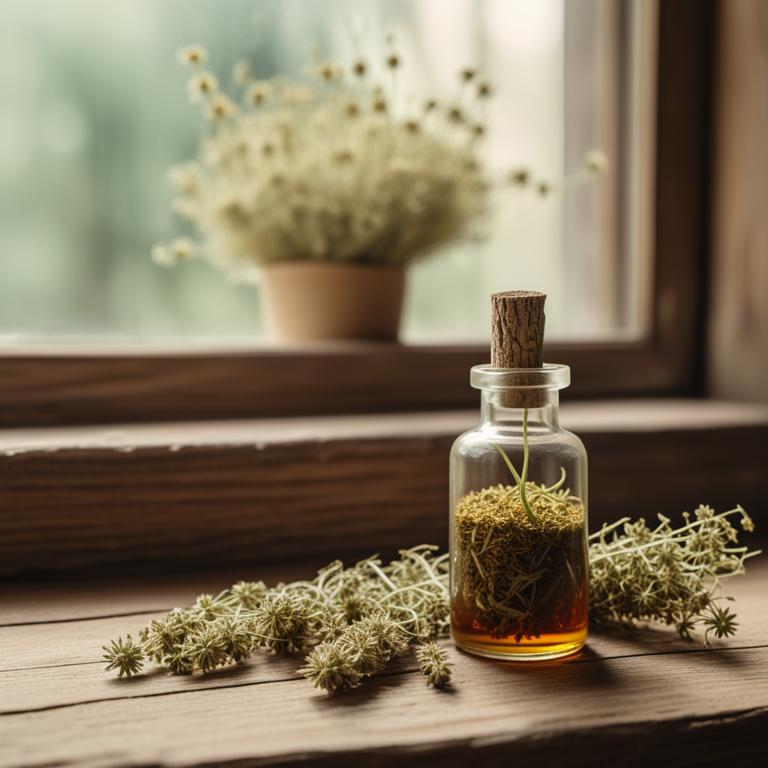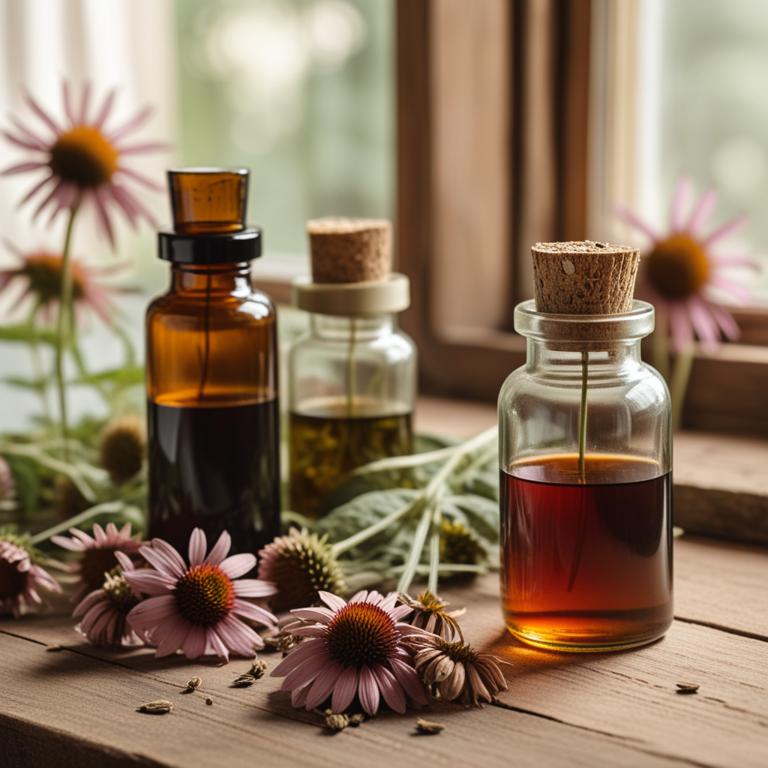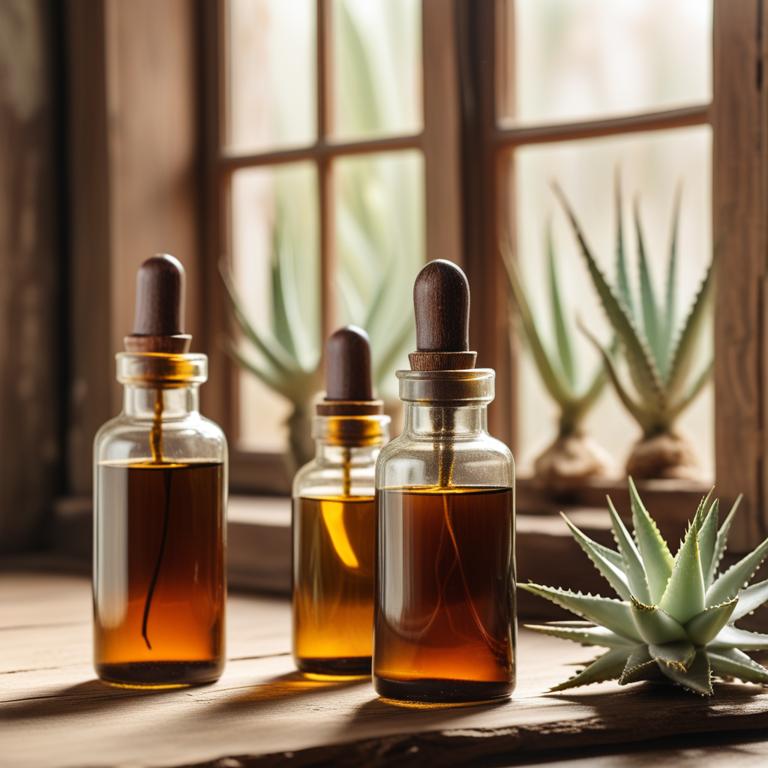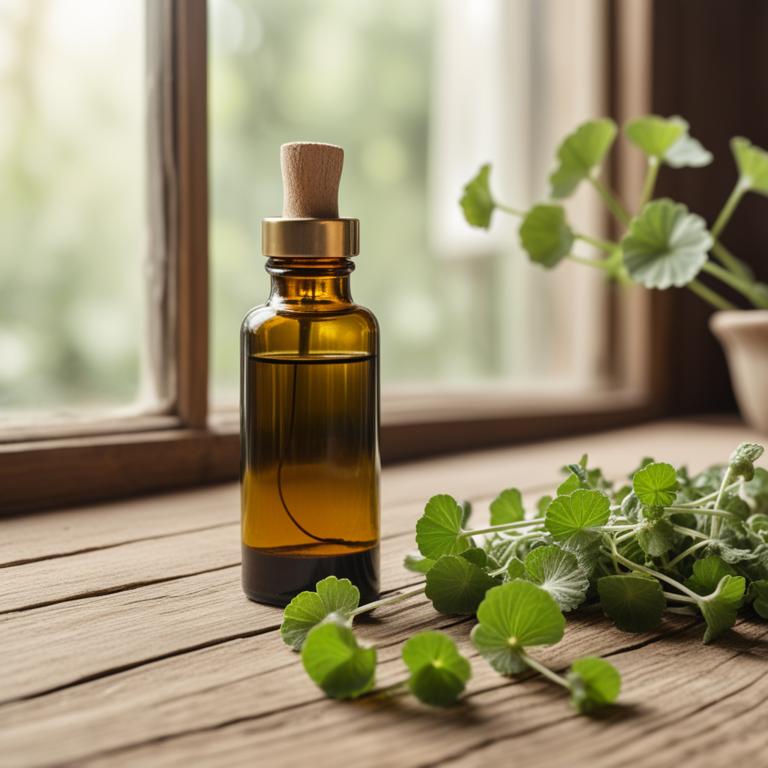9 Best Herbal Tinctures For Red Eyes

Herbal tinctures for Red eyes are concentrated liquid extracts made from plant-based ingredients, specifically designed to provide relief from red, itchy, and inflamed eyes.
These herbal remedies have gained popularity due to their natural benefits, which include reducing inflammation, soothing irritated tissues, and promoting overall eye health.
Examples of herbal tinctures used to treat red eyes include Eyebright, which has antiseptic and anti-inflammatory properties, Calendula, which has anti-inflammatory and antimicrobial properties, and Aloe Vera, which has soothing and moisturizing effects.
Other herbal tinctures such as Nettle Leaf, Chamomile, and Peppermint are also used to treat red eyes due to their ability to reduce inflammation, calm the eyes, and provide antioxidant properties.
According to "Journal of alternative and complementary medicine (New York, N.Y.)", tinctures for red eyes, specifically eye drops made from Euphrasia rostkoviana Hayne, have been found to be effective in treating inflammatory and catarrhal conjunctivitis, with a dosage of one drop three times a day being a commonly prescribed amount.
Below there's a list of the 9 best herbal tinctures for red eyes.
- 1. Euphrasia officinalis tinctures
- 2. Urtica dioica tinctures
- 3. Echinacea purpurea tinctures
- 4. Aloe barbadensis tinctures
- 5. Centella asiatica tinctures
- 6. Achillea millefolium tinctures
- 7. Hypericum perforatum tinctures
- 8. Calendula officinalis tinctures
- 9. Euphorbia peplus tinctures
Also you may be interested in...
TODAY'S FREE BOUNDLE
Herb Drying Checklist + Herbal Tea Shopping List + Medicinal Herbs Flashcards
Enter you best email address below to receive this bundle (3 product valued $19.95) for FREE + exclusive access to The Aphotecary Letter.
$19.95 -> $0.00
1. Euphrasia officinalis tinctures

Euphrasia officinalis tinctures have been traditionally used to treat the red eyes ailment, also known as conjunctivitis, due to its anti-inflammatory and antimicrobial properties that help to soothe and calm the irritated eyes.
The bioactive constituents of Euphrasia officinalis, such as flavonoids and phenolic acids, possess potent antioxidant and anti-inflammatory activities that help to reduce swelling and combat infection in the eyes.
By reducing inflammation and promoting healing, Euphrasia officinalis tinctures can effectively alleviate the symptoms of red eyes, including redness, itching, and discharge.
The benefits of using Euphrasia officinalis tinctures to treat red eyes include a reduction in inflammation, improved healing rates, and a decrease in the risk of complications and scarring.
2. Urtica dioica tinctures

Urtica dioica tinctures, made from the leaves of the stinging nettle plant, have been traditionally used to treat red, itchy, and inflamed eyes due to their anti-inflammatory and antihistaminic properties.
The herbal preparation helps to treat this ailment by reducing swelling, soothing irritation, and alleviating discomfort associated with red eyes.
The bioactive constituents of Urtica dioica tinctures, including flavonoids, phenolic acids, and sterols, contribute to their therapeutic effects by modulating the immune response and reducing inflammation.
The benefits of using Urtica dioica tinctures to treat red eyes include reduced redness, itching, and swelling, as well as improved overall eye health and comfort.
3. Echinacea purpurea tinctures

Echinacea purpurea tinctures have been used to treat the red eyes ailment due to their anti-inflammatory and immune-boosting properties, which help to reduce the severity of the condition.
The herbal preparation contains bioactive constituents such as alkylamides and phenolic acids, which have been shown to have immunomodulatory and antioxidant effects, helping to alleviate the symptoms of red eyes.
By reducing inflammation and enhancing the body's natural defense mechanisms, Echinacea purpurea tinctures can help to provide relief from red, itchy, and watery eyes.
The benefits of using Echinacea purpurea tinctures to treat red eyes include reduced inflammation, improved eye health, and a shorter recovery time, making it a popular natural remedy for this common ailment.
4. Aloe barbadensis tinctures

Aloe barbadensis tinctures have been traditionally used to treat red eyes, also known as conjunctivitis, due to their anti-inflammatory and soothing properties.
The bioactive constituents present in Aloe barbadensis tinctures, such as aloin and aloe-emodin, help to reduce inflammation and alleviate symptoms associated with red eyes.
These herbal preparations work by calming the affected area, reducing redness and swelling, and promoting the healing process.
The benefits of using Aloe barbadensis tinctures to treat red eyes include reduced discomfort, accelerated recovery, and a reduced risk of complications associated with prolonged inflammation.
5. Centella asiatica tinctures

Centella asiatica tinctures are a herbal preparation derived from the plant Centella asiatica, also known as gotu kola, which has been traditionally used to treat various health issues, including red eyes, also known as conjunctivitis.
The tinctures' anti-inflammatory and antioxidant properties help to reduce swelling and soothe the affected area, thereby alleviating the discomfort associated with this ailment.
The bioactive constituents of Centella asiatica, such as asiatic acid and madecassoside, have been found to possess potent anti-inflammatory and antimicrobial properties that help to combat the underlying causes of conjunctivitis.
Regular use of Centella asiatica tinctures has been found to promote quick recovery from red eyes and provide long-term benefits, including enhanced eye health and reduced susceptibility to future infections.
6. Achillea millefolium tinctures

Achillea millefolium tinctures, derived from the leaves and flowers of the yarrow plant, have been traditionally used to treat the red eyes ailment, also known as conjunctivitis.
The tincture's anti-inflammatory and antimicrobial properties help to reduce redness and swelling, while its astringent properties aid in drying out excess discharge and promoting healing.
The bioactive constituents of yarrow, including sesquiterpenes, flavonoids, and phenolic acids, contribute to its therapeutic effects, including its ability to inhibit the growth of pathogens and reduce inflammation.
By using Achillea millefolium tinctures, individuals can benefit from a natural and non-invasive approach to treating the red eyes ailment, reducing the risk of complications and promoting a speedy recovery.
7. Hypericum perforatum tinctures

Hypericum perforatum tinctures, derived from the herb St. John's Wort, have been traditionally used to treat red eyes, a common condition characterized by inflammation and irritation.
The anti-inflammatory and antioxidant properties of this herbal preparation help to reduce swelling and soothe the affected area, providing relief from discomfort and pain.
The bioactive constituents, including flavonoids, phenolic acids, and terpenoids, work together to inhibit the production of pro-inflammatory mediators and promote healing.
The benefits of using Hypericum perforatum tinctures to treat red eyes include reduced inflammation, improved eye health, and enhanced overall well-being, making it a popular natural remedy for this common ailment.
8. Calendula officinalis tinctures

Calendula officinalis tinctures have been traditionally used to treat red eyes, a condition often caused by inflammation, irritation, or infection of the conjunctiva.
The anti-inflammatory, antiseptic, and antimicrobial properties of calendula tinctures help to soothe and calm the affected area, reducing redness and discomfort.
The bioactive constituents of calendula, including triterpenoids, carotenoids, and flavonoids, contribute to its therapeutic effects, exerting their anti-inflammatory and antioxidant actions to promote healing and tissue repair.
By utilizing calendula tinctures, individuals can benefit from their natural ability to reduce redness, promote comfort, and expedite recovery from red eyes, making them a popular choice for herbal remedies.
9. Euphorbia peplus tinctures

Euphorbia peplus tinctures have been traditionally used to treat the red eyes ailment, also known as conjunctivitis, due to their anti-inflammatory and antiseptic properties.
The tincture's active compounds, such as ingenol mebutate and phorbol esters, help to reduce inflammation and combat bacterial infections in the eyes.
By reducing redness and swelling, Euphorbia peplus tinctures provide relief from discomfort and promote the healing of the affected area.
The benefits of using Euphorbia peplus tinctures to treat red eyes include their non-invasive nature, ease of use, and potential to reduce the need for antibiotics and other medications.